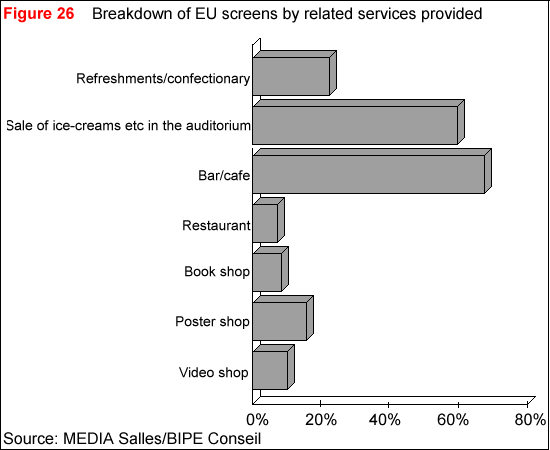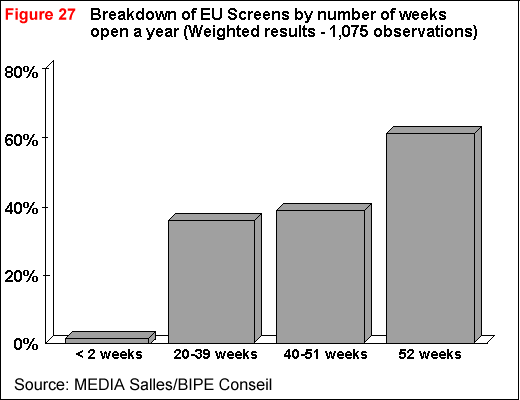4.3
Quality of service
As well as the technical level of the infrastructure
and the nature of programming, a third dimension helps us characterise
the commercial position of the cinemas: the quality of service. This includes,
amongst other things, the sale of related products, new methods of payment
and the number of weeks per year that the cinema opens: these are the factors
which we have chosen to consider here.
The sale of related products
The sale of related products is closely tied to a strategy of cinema
renewal: the modernisation of a cinemas is accompanied in many cases by
a restructuring of the foyer and the positioning there of a confectionery
counter: automatic dispensers have also been successful as a substitute
for in-auditorium sales, and more recently cafés have been introduced
(see Figure number 26).
Whatever the sales method, confectionery gives a net profit margin
of 30-35%. The new methods of marketing related products can, in the most
modern complexes, represent sales of 1-1.3 ECU per spectator, or 30-40%
of the exhibitors' takings, which is very close to the average results
observed in the United States. In cases like these, the suppliers become
the real partners of the cinemas. However, in the majority of European
cinemas, the turnover achieved by related products remains limited to between
10 and 15% of takings.
This market is still embryonic, and could see substantial developments.
But it presupposes an ability to invest the necessary for the relevant
modernisation, which nowadays only the multiplexes can generally achieve.
The picture does, of course, vary between a country whose sector conforms
to the intensive model, where related product revenues form an integral
part of cinema services, and a country following the extensive model, where
there is only a marginal diversification of products. Some southern countries
form exceptions to this rule (Greece, Portugal), as cinemas there are also
bars.


Cinema opening hours
The cinema's hours of business, expressed as the number of weeks open
per year and the number of weekly screenings per screen, increases with
the number of screens on a site. The hours of business are equally high
for circuits and independently-owned cinemas. Multiplexes which do not
open 52 weeks of the year are rare, however, only 33% of single-screen
cinemas open all the year round. All the others are closed for several
weeks, or give way to non-cinema operations (live show etc.). The average
European cinema shows films for 48.5 weeks a year, and has around 20 screenings
per screen per week (or a little less than 3 screenings a day) (see
Tables 32 and 33).
The multiplexes are not only distinguished from the others by a greater
diversification of service; they differ from single-screen cinemas because
they provide a continuous service.
|
Table 32: Average number
of weekly screenings per screen
|
| |
Annual Average
|
| Single-screen cinemas |
16.28
|
| 2 screen complexes |
16.47
|
| 3-5 screen complexes |
19.50
|
| 6-7 screen complexes |
25.16
|
| Complexes with more than 8 screens |
26.08
|
| All Screens |
19.82
|
| Source: MEDIA Salles/BIPE Conseil |
|
Table 33: Breakdown of screens by number of weekly
screenings per screen and cinema ownership
|
| |
Less than 7 screenings per week
|
7 to 14
screenings per week
|
15 to 24 screenings per week
|
More than 25 screenings per week
|
| Owned by a circuit |
8.0%
|
11.5%
|
31.4%
|
49.1%
|
| Owned by an independent |
10.6%
|
27.9%
|
47.5%
|
14.0%
|
| Owned by a public authority or a non-profit
making organisation |
26.6%
|
34.5%
|
30.1%
|
8.8%
|
New methods of buying tickets
To develop customer loyalty, exhibitors have introduced new methods
of buying tickets, particularly season tickets. These season tickets illustrate
real marketing skills: they help the exhibitor be sure of customer loyalty,
by allowing pre-payment (and thus making a substantial financial gain);
they also constitute a way of predicting behaviour patterns, and facilitate
the introduction of new pricing strategies.
The circuits have made abundant recourse to this method of payment.
For example, UGC announced that it achieved 15% of its ticket sales through
its Privilege Card, which offers the user greater convenience (no queues,
preferential prices).






